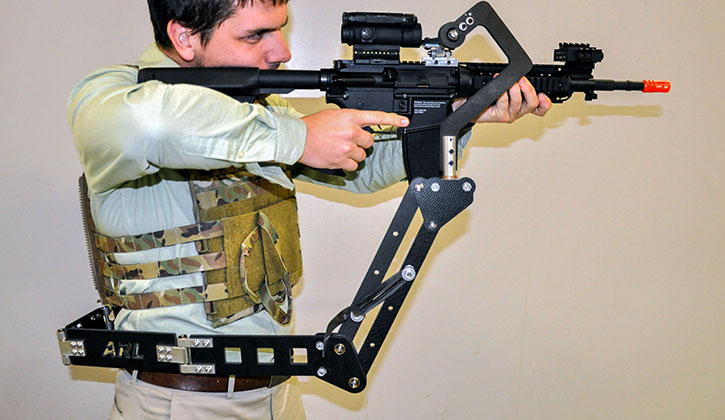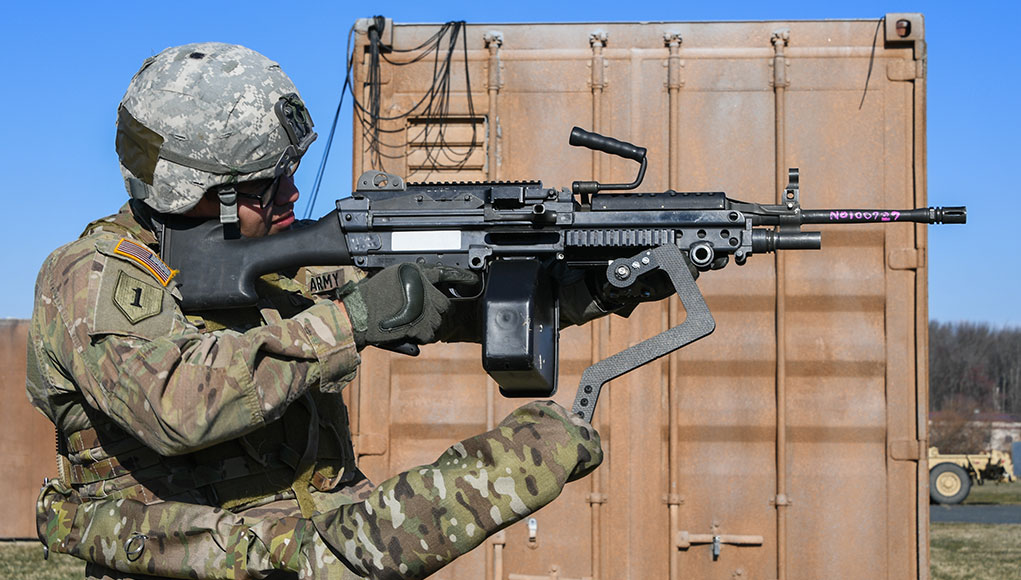Engineers are working diligently to reduce the weight Marines and soldiers carry in action, but engineers at the U.S. Army Research lab took a different approach – adding limbs to improve soldier lethality. Dan Baechle, a mechanical engineer at the lab constructed a device that better distributes the weapon’s load, stabilizing the weapon when entering fire positions, enabling the soldier to aim and shoot as quickly and accurately as possible. Unlike other, complex exoskeletons, the device produced by Baechle is made of composite materials that are lightweight and does not requires batteries to operate.
Called the ‘Third Arm’, the 4 pound (1.814 kg) device helps to reduce the weapon’s weight off of the Soldiers’ arms and better distribute it through the skeleton. The weight of the apparatus is less than four pounds.
“It can help stabilize the weapon and take the load off of their arms,” he said. “It’s made from composite materials to make it as light as possible, but also to ensure the range of motion that Soldiers need. We’ve actually tested it with the M249 and M240B machines guns. The M240B weighs 27 pounds (12.25 kg), and we were able to show that you can take the weight of that weapon completely off of the Soldiers’ arms,” Baechle said, adding that they also look at heavier weapons. In 2017, the lab conducted a small pilot study of active-duty troops using Third Arm in live-fire trials. The results showed the device can improve marksmanship, reduce arm fatigue and muscle activation for some Soldiers.

Baechle was able to improve the design by testing it with soldiers using the Third Arm prototype with various weapons and in different positions. At a recent test with a Soldier at the Military Operations in Urban Terrain site at the Aberdeen Proving Ground, a sergeant wore the device with an M-4 type weapon and dove into a prone fighting position from a sprint. The Third Arm provided immediate stabilization to improve marksmanship for the Soldier.
Baechle said that the Army modernization priorities include “Soldier lethality that spans all fundamentals — shooting, moving, communicating, protecting and sustaining.” Further documentation specifically mentions the fielding of “load-bearing exoskeletons. The Third Arm falls in line with the direction that the Army wants to be heading in the future,” Baechle said. “We get comments from Soldiers who tell us different things about the way it feels on their body about the way it redistributes the load. Some like it, some give us tips about the ways it could be improved, and we’re using that input to improve the device and improve the design so that it not only works well, but it also feels good.”
“We’re using that small study to motivate a larger study this year with more Soldiers taking a look at dynamics, shooting scenarios,” Baechle said. “We’re still refining the device. ”























